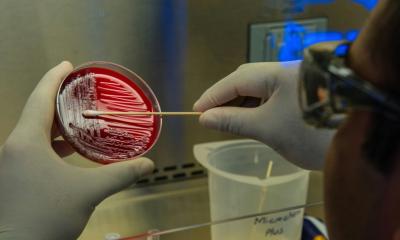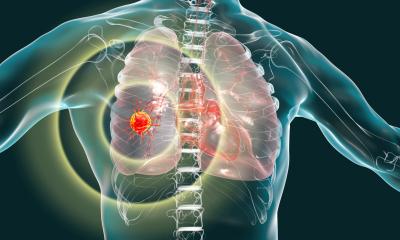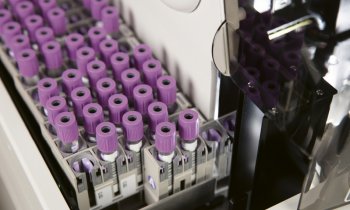News • Respiratory failure and sepsis
Cheap, quick test identifies major risks for pneumonia patients
Spanish researchers in Valencia have identified specific fragments of genetic material that play a role in the development of respiratory failure and sepsis in pneumonia patients.
Image source: Mikael Häggström, M.D., X-ray of lobar pneumonia, CC0 1.0 (marked as public domain)
Presenting the research at the European Respiratory Society International Congress, Dr Francisco Sanz said the findings could enable doctors to test quickly for these biological markers when a patient is admitted to hospital with pneumonia, so that they could anticipate complications and provide more intensive support and monitoring. Dr Sanz, a pulmonologist in the Pulmonary Department at Consorci Hospital Universitari de València and an associate professor at the University of Valencia, and his colleagues analysed clinical data and blood samples from 169 patients with community-acquired pneumonia – pneumonia acquired outside the hospital or nursing home setting.
The potential use of these biomarkers would be at the time of admission of patients in order to anticipate the complications that they could develop
Francisco Sanz
Dr Sanz said: “Pneumonia is an infection of the lung tissue by viruses or bacteria. The worst complications are the development of respiratory failure and sepsis, which is when the infection spreads via the blood stream to the rest of the body. There are small molecules called microRNAs, which are fragments of genetic material that regulate how genes behave. We have found that for each type of complication – respiratory failure or sepsis – there is a specific microRNA involved.”
The researchers used real-time polymerase chain reaction (PCR) techniques, which is a method used to make copies of small sections of DNA, to identify the microRNAs in the blood samples taken from patients at the time they were admitted to hospital. Then they examined correlations between the microRNAs and sepsis and respiratory failure to see how well certain microRNAs could predict these complications.
They found that three microRNAS that were already known to be involved in lung and systemic inflammatory processes were good at predicting sepsis or respiratory failure. Of the 169 patients, 109 (64.5%) developed complications, with 25.4% developing respiratory failure and 13.6% severe sepsis. MicroRNA 223 was good at predicting the onset of sepsis (78% accurate), and microRNA 574 was good at predicting respiratory failure (77% accurate). MicroRNA 182 was good at predicting both severe sepsis and respiratory failure (with 83% and 76% accuracy, respectively).
Dr Sanz said: “Our study has improved our understanding of the changes and processes that occur in the body in response to pneumonia by identifying these microRNAs that specifically determine complications, such as sepsis and respiratory failure. This has implications for prognosis. The potential use of these biomarkers would be at the time of admission of patients in order to anticipate the complications that they could develop. Once it was detected that the patient has a certain profile of microRNAs, more intensive support or monitoring measures could be implemented. The test is fast – it takes between one and three hours – and cheap, and it can be performed with techniques that are available in most hospitals.”
Recommended article

News • Pulmonary complications
Simple breathing training before surgery prevents postoperative pneumonia
Pneumonia, and other serious lung complications, after major abdominal surgery were halved when patients were seen by a physiotherapist before surgery and taught breathing exercises that the patient needed to start performing immediately on waking from the operation, finds a trial published by The BMJ today. The researchers say their results “are directly applicable to the tens of millions of…
The average age of the patients was 67 years (ranging from 58 to 79), and several had other health problems: 29% had diabetes, 28% had chronic obstructive pulmonary disease (COPD) and 14% had an irregular heart beat. Nearly 4% of the patients (3.6%) died after being admitted to hospital. The patients were admitted to the Consorci Hospital Universitari and the Hospital Clínic in Valencia, Spain, and the researchers collaborated with Dr Francisco Dasí and Ms Silvia Vicente from INCLIVA Health Research Institute in Valencia. Dr Sanz concluded: “Our study has been conducted in the hospital setting but could be used for outpatients too. In addition, due to the range of ages of the patients in our study, this could be applied to adult patients of all ages, although we cannot extrapolate the results to children.”
Professor Tobias Welte from Hannover University, Germany, is President of the European Respiratory Society and was not involved in the study. He said: “Anyone can get pneumonia, even people who are fit and healthy. However, it is more likely to occur in vulnerable individuals such as the very young or elderly people. These groups are also more likely to be affected by complications like sepsis and respiratory failure following pneumococcal infection. The innovative approach described in this study could provide a quick and cost-effective method for identifying patients at risk of developing sepsis or respiratory failure, which has the potential to save lives and improve patient quality of life, as well as reduce costs for health care providers. However, this test will have to be compared to guidelines and recommended best clinical practice to confirm its usefulness.”
Source: European Respiratory Society (ERS) International Congress
02.10.2019











